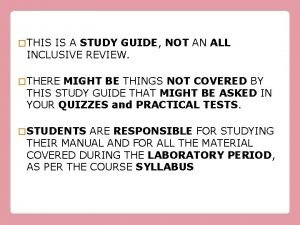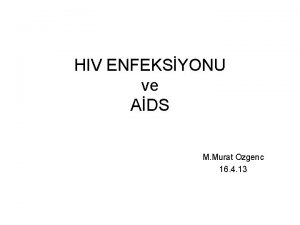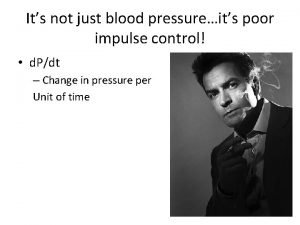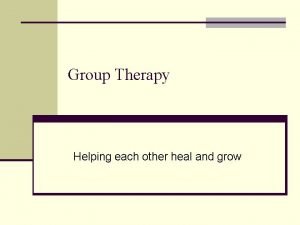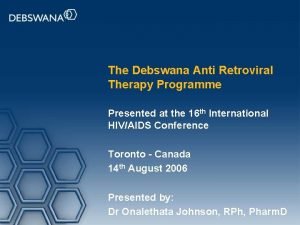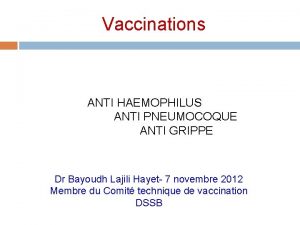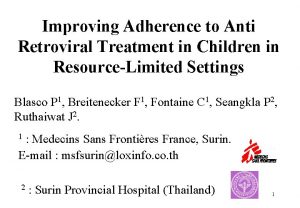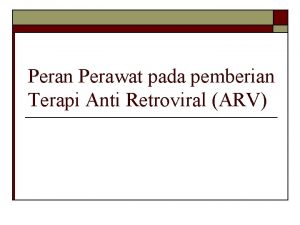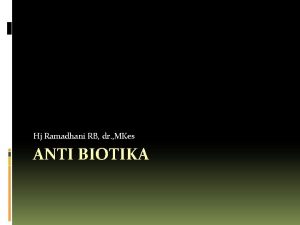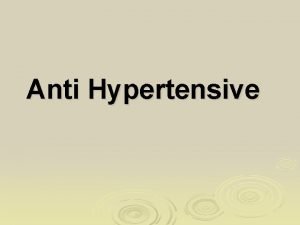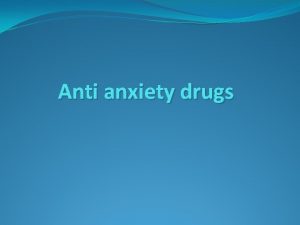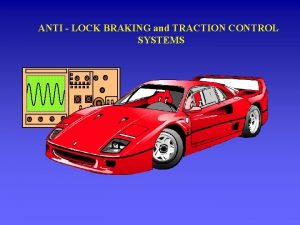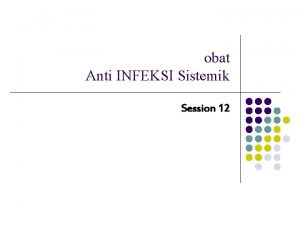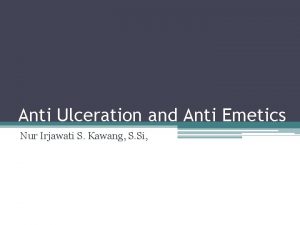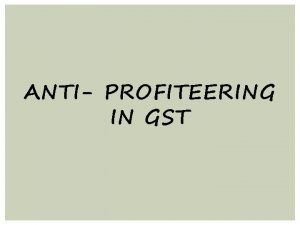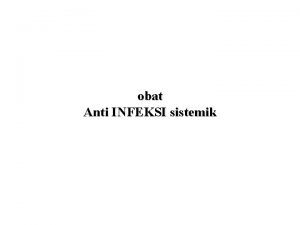The Development of Anti Retroviral Therapy in Africa




























- Slides: 28

The Development of Anti. Retroviral Therapy in Africa (DART) trial Comparison of routine vs clinically driven laboratory monitoring in HIV-infected African adults over 5 years on ART: Final results of the DART trial Peter Mugyenyi on behalf of the DART Trial Team IAS July 2009 1

Main objective of DART • To evaluate the need for routine laboratory monitoring of ART – in African adults who fulfilled clinical and CD 4 criteria for ART initiation – in terms of clinical effectiveness, safety and costs • Primary endpoints – Efficacy: new WHO stage 4 HIV event (AIDS) or death – Safety: any Serious Adverse Event which is not only HIV-related IAS July 2009 2

Trial design 3316 ART-naive adults with stage WHO 2, 3 or 4 HIV disease, CD 4<200 cells/mm 3 initiating triple drug ART Laboratory and Clinical Monitoring (LCM) 12 weekly biochemistry, FBC & CD 4 Other investigations & concomitant medications if clinically indicated Switch to second-line for • new/recurrent WHO 4 (or multiple WHO 3) • CD 4<100 cells/mm 3 IAS July 2009 randomise Clinically Driven Monitoring (CDM) 12 weekly biochemistry, FBC & CD 4; FBC & biochemistry only returned if clinically indicated (or grade 4 toxicity); CD 4 never returned Other investigations & concomitant medications if clinically indicated Switch to second-line for new/recurrent WHO 4 (or multiple WHO 3) As per WHO guidelines, switching before 48 weeks discouraged in both arms 3

Trial status • 6578 patients screened • 3316 patients randomised to CDM or LCM – between 15 January 2003 and 28 October 2004 • Final data to 31 December 2008 (max 6, median 4. 9 years) – during Jan 2009, all laboratory tests returned to CDM participants – participants transitioned care into Ugandan and Zimbabwean national ART programmes (except those in second-line studies) – results of second-line studies expected early 2010 IAS July 2009 4

Characteristics at baseline (ART initiation) LCM N=1656 Women 1092 Age (years) median (range) CD 4 count (cells/mm 3) median <50 cells/mm 3 CDM N=1660 66% 1064 64% 36 (18 -67) 36 (18 -73) 86 (0 -199) 86 (1 -199) 554 33% 555 33% HIV-1 RNA (log 10 copies/ml) mean (SD)* 5. 4 (0. 7) WHO stage 363 916 377 22% 55% 23% 310 948 402 19% 57% 24% On cotrimoxazole before/at ART initiation 1014 61% 1034 62% ART: ZDV+3 TC plus 1232 150 274 74% 9% 16% 1237 123 273 75% 9% 16% 65 4% 23 2% 38 4% 2 3 4 TDF ABC NVP Identified at any time (including postbaseline) as having previously received ART Previous ART for MTCT (% of women) IAS July 2009 * assayed in a subset (N=968) at baseline only 5

Follow-up • Median follow-up to 31 December 2008 4. 9 years (IQR 4. 5 -5. 3) – 14, 937 person-years – 236 (7%) lost to follow-up – 98% and 99% of expected nurse and doctor visits attended – high patient-reported adherence Blinding of laboratory test results in the CDM arm • Few CDM participants sought external CD 4 counts – clinicians remained blinded – at DART exit, 81/1281 (6%) reported having CD 4 s done privately • 43/81 had 1 CD 4 test only • 3/81 had 6 or more IAS July 2009 6

Adverse events Proportion event-free 1. 0 SAE p=0. 20 0. 8 ARTmodifying AE p=0. 85 Grade 4 AE p=0. 18 0. 6 0. 4 Grade 3/4 AE p=0. 52 0. 2 LCM CDM 0. 0 0 1 2 3 4 5 Years from randomisation (ART initiation) IAS July 2009 7

Antiretroviral therapy At last follow-up/31 December 2008 Remained on first-line CDM N=1660 1295 78% 1346 81% 1014 61% 1059 64% - substituted CBV only 113 7% 98 6% - substituted third drug (±CBV) 162 10% 179 11% 6 0. 4% 10 0. 6% 361 22% 314 19% - still taking original first-line regimen - off ART for >90 days Had switched to second-line IAS July 2009 LCM N=1656 8

Switch to second-line 0. 5 HR(CDM: LCM) = 0. 84 (95% CI 0. 72 -0. 98), p=0. 03 0. 4 Proportion 0. 3 switched to second-line 0. 2 (cumulative incidence) 0. 1 LCM CDM 0. 0 0 1 2 3 4 5 Years from randomisation (ART initiation) HR(CDM: LCM) IAS July 2009 0. 48 0. 77 0. 90 heterogeneity p=0. 001 1. 35 1. 10 9

Proportion alive without a new WHO 4 event Progression to new WHO 4 event or death (primary endpoint) 1. 0 0. 88 0. 82 0. 88 0. 78 0. 79 0. 72 0. 6 356 events LCM: 5. 2/100 PY CDM: 6. 9/100 PY 459 events 0. 4 0. 2 0. 0 0 LCM: n= CDM: n= IAS July 2009 1656 1660 1 2 3 4 5 1438 1443 1364 1354 1306 1262 1255 1184 682 613 Years from randomisation (ART initiation) 10

Proportion alive without a new WHO 4 event Progression to new WHO 4 event or death (primary endpoint) 1. 0 0. 88 0. 82 0. 88 0. 78 0. 79 0. 72 0. 6 356 events LCM: 5. 2/100 PY CDM: 6. 9/100 PY 459 events 0. 4 0. 2 0. 0 HR(CDM: LCM) = 1. 31 (95% CI 1. 14 -1. 51) p=0. 0001 0 LCM: n= CDM: n= IAS July 2009 1656 1660 1 2 3 4 5 1438 1443 1364 1354 1306 1262 1255 1184 682 613 Years from randomisation (ART initiation) 11

Survival Proportion alive 1. 0 0. 8 0. 95 0. 92 0. 90 0. 94 0. 90 0. 87 164 events LCM: 2. 2/100 PY CDM: 2. 9/100 PY 218 events 0. 6 0. 4 0. 2 HR(CDM: LCM) = 1. 35 (1. 10 -1. 65) p=0. 004 Number needed to monitor for 1 year to prevent 1 event =130 0. 0 0 LCM CDM IAS July 2009 1656 1660 1 2 3 4 5 1552 1542 1501 1494 1468 1445 1436 1395 796 749 Years from randomisation (ART initiation) 12

Survival Proportion alive 1. 0 0. 8 0. 55 0. 6 0. 4 0. 18 0. 2 0. 08 0. 0 0 IAS July 2009 1 2 3 4 Years from enrolment 5 Entebbe Cohort (Uganda): pre-ART 19962000, median CD 4 75 at enrolment: 57. 7/100 PY 13

Survival Proportion alive 1. 0 0. 94 0. 8 0. 90 0. 87 0. 55 0. 6 0. 4 0. 18 0. 2 0. 08 0. 0 0 IAS July 2009 CDM: 2. 9/100 PY 218 events 1 2 3 4 Years from enrolment 5 Entebbe Cohort (Uganda): pre-ART 19962000, median CD 4 75 at enrolment: 57. 7/100 PY 14

Survival Proportion alive 1. 0 0. 8 0. 95 0. 92 0. 90 0. 94 0. 90 0. 87 0. 55 0. 6 0. 4 0. 18 0. 2 0. 08 0. 0 0 IAS July 2009 164 events LCM: 2. 2/100 PY CDM: 2. 9/100 PY 218 events 1 2 3 4 Years from enrolment 5 Entebbe Cohort (Uganda): pre-ART 19962000, median CD 4 75 at enrolment: 57. 7/100 PY 15

Absolute event rates over time on ART predicted rate of new WHO 4/death in LCM 0 -<2 years CDM 0 -<2 years Death New WHO 4/death (PRIMARY) 0 2 4 6 8 10 12 Rate per 100 PY (95% CI) IAS July 2009 16

Absolute event rates over time on ART predicted rate of new WHO 4/death in LCM 0 -<2 years CDM 0 -<2 years LCM 2 -6 years CDM 2 -6 years Death New WHO 4/death (PRIMARY) 0 2 4 6 8 10 12 Rate per 100 PY (95% CI) IAS July 2009 17

Absolute event rates over time on ART predicted rate of new WHO 4/death in LCM 0 -<2 years CDM 0 -<2 years LCM 2 -6 years CDM 2 -6 years Death New WHO 4/death (PRIMARY) EXCLUDING oesophageal candidiasis New severe WHO 4/death 0 2 4 6 8 10 12 Rate per 100 PY (95% CI) IAS July 2009 18

Main Finding • There is a small but statistically significant difference in mortality and disease progression between the two arms only from the third year on ART • What causes this? IAS July 2009 19

Explanation • There is a small but statistically significant difference in mortality and disease progression between the two arms only from the third year on ART • What causes this? • Slightly later switching to second-line therapy in CDM leading to a few more patients in CDM living with lower CD 4 counts on first-line and at increased risk of clinical events IAS July 2009 20

Most recent CD 4 on first-line Median 372 338 800 Last CD 4 (cells/mm 3) 700 600 75% 500 400 300 250 200 100 50 0 1% 1% LCM IAS July 2009 70% 3% 4% CDM last seen alive on first-line 21

Most recent CD 4 on first-line Median 372 338 800 Last CD 4 (cells/mm 3) 700 600 75% 500 400 300 250 200 100 50 0 1% 1% LCM IAS July 2009 70% 3% 4% CDM last seen alive on first-line 22

Most recent CD 4 on first-line Median 372 338 100 60 800 Last CD 4 (cells/mm 3) 700 600 75% 500 19% 3% 4% 18% 32% 9% 400 300 250 200 100 50 0 1% 1% LCM IAS July 2009 70% CDM last seen alive on first-line LCM 20% 46% CDM died on first-line 23

Most recent CD 4 on first-line Median 372 338 100 60 800 Last CD 4 (cells/mm 3) 700 600 75% 500 19% 3% 4% 18% 32% 9% 400 300 250 200 100 50 0 1% 1% LCM IAS July 2009 70% CDM last seen alive on first-line LCM 20% 46% CDM died on first-line 24

Most recent CD 4 on first-line or at switch Median 372 338 100 60 63 56 800 Last CD 4 (cells/mm 3) 700 600 75% 500 19% 3% 4% 18% 32% 9% 2% 20% 400 300 250 200 100 50 0 1% 1% LCM IAS July 2009 70% CDM last seen alive on first-line LCM 20% 46% CDM died on first-line 38% 40% LCM 16% 48% CDM switched to second-line 25

Most recent CD 4 on first-line or at switch Median 372 338 100 60 63 56 800 Last CD 4 (cells/mm 3) 700 600 75% 500 19% 3% 4% 18% 32% 9% 2% 20% 400 300 250 200 100 50 0 1% 1% LCM IAS July 2009 70% CDM last seen alive on first-line LCM 20% 46% CDM died on first-line 38% 40% LCM 16% 48% CDM switched to second-line 26

450 LCM 400 CDM 350 300 250 200 150 288 276 264 252 240 216 204 192 180 168 156 144 132 120 108 96 84 72 60 48 36 0 24 100 228 global p=0. 02 12 (pointwise 95% CI) Mean absolute CD 4 (cells/mm 3) Absolute change in CD 4 over 5 years Weeks from randomisation (ART initiation) IAS July 2009 NB: some participants were on STIs at weeks 60, 84 and 108 27

Conclusions • 5 -year survival in 3316 participants with advanced HIV disease pre-ART was excellent (CDM 87%, LCM 90%) • Loss to follow-up was very low • Routine laboratory monitoring for toxicity did not impact adverse events or substitutions in first-line • 12 -weekly CD 4 monitoring had no impact on disease progression during the first 2 years on ART – after 2 years, a small but significant impact on clinical disease progression favouring LCM appeared to be driven by later switch to second-line ART in CDM – there may be a role for targeted, as opposed to routine, CD 4 monitoring from the second year on ART IAS July 2009 28
 Anti a anti b anti rh blood type
Anti a anti b anti rh blood type Akut retroviral sendrom
Akut retroviral sendrom Anti impulse therapy
Anti impulse therapy Both psychoanalysis and humanistic therapy stress
Both psychoanalysis and humanistic therapy stress Bioness integrated therapy system occupational therapy
Bioness integrated therapy system occupational therapy Psychoanalytic therapy is to as humanistic therapy is to
Psychoanalytic therapy is to as humanistic therapy is to Group therapy stages of development
Group therapy stages of development Community development was written by
Community development was written by Conclusion for training and development ppt
Conclusion for training and development ppt Hình ảnh bộ gõ cơ thể búng tay
Hình ảnh bộ gõ cơ thể búng tay Ng-html
Ng-html Bổ thể
Bổ thể Tỉ lệ cơ thể trẻ em
Tỉ lệ cơ thể trẻ em Voi kéo gỗ như thế nào
Voi kéo gỗ như thế nào Chụp tư thế worms-breton
Chụp tư thế worms-breton Chúa yêu trần thế alleluia
Chúa yêu trần thế alleluia Các môn thể thao bắt đầu bằng tiếng đua
Các môn thể thao bắt đầu bằng tiếng đua Thế nào là hệ số cao nhất
Thế nào là hệ số cao nhất Các châu lục và đại dương trên thế giới
Các châu lục và đại dương trên thế giới Công thức tính thế năng
Công thức tính thế năng Trời xanh đây là của chúng ta thể thơ
Trời xanh đây là của chúng ta thể thơ Mật thư tọa độ 5x5
Mật thư tọa độ 5x5 Làm thế nào để 102-1=99
Làm thế nào để 102-1=99 Phản ứng thế ankan
Phản ứng thế ankan Các châu lục và đại dương trên thế giới
Các châu lục và đại dương trên thế giới Thể thơ truyền thống
Thể thơ truyền thống Quá trình desamine hóa có thể tạo ra
Quá trình desamine hóa có thể tạo ra Một số thể thơ truyền thống
Một số thể thơ truyền thống Cái miệng nó xinh thế chỉ nói điều hay thôi
Cái miệng nó xinh thế chỉ nói điều hay thôi
